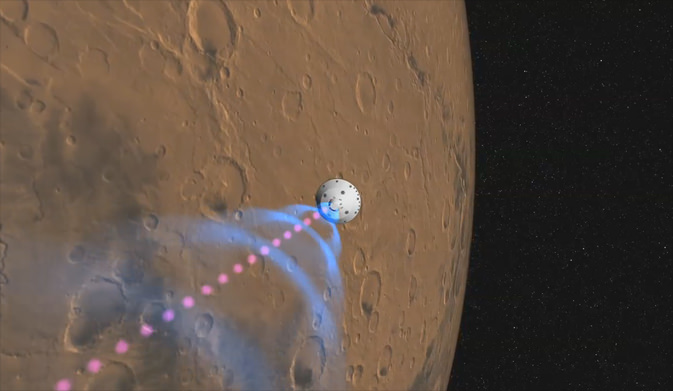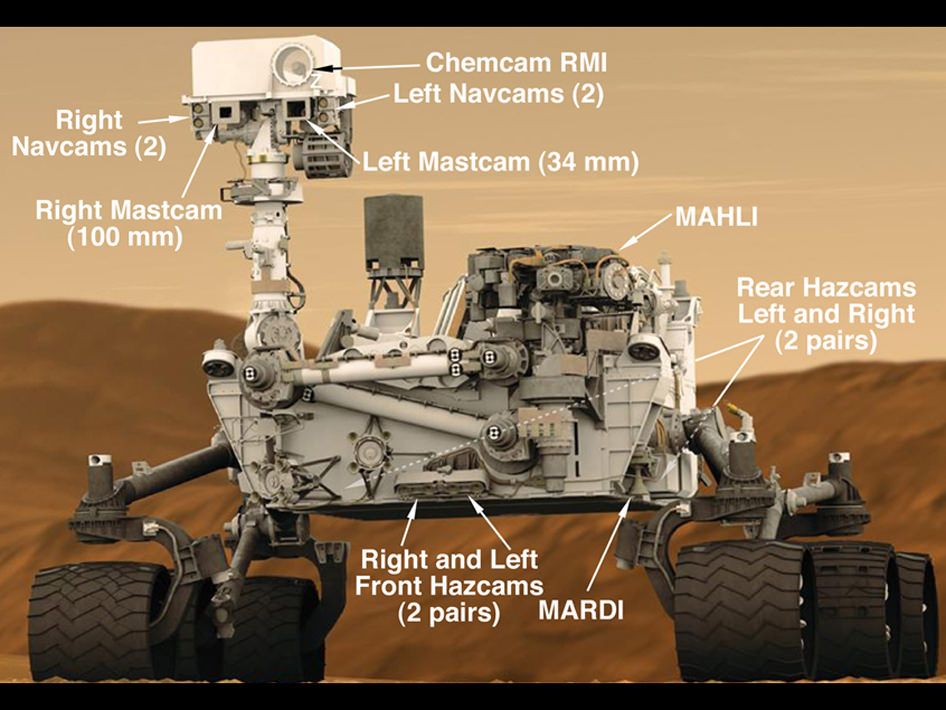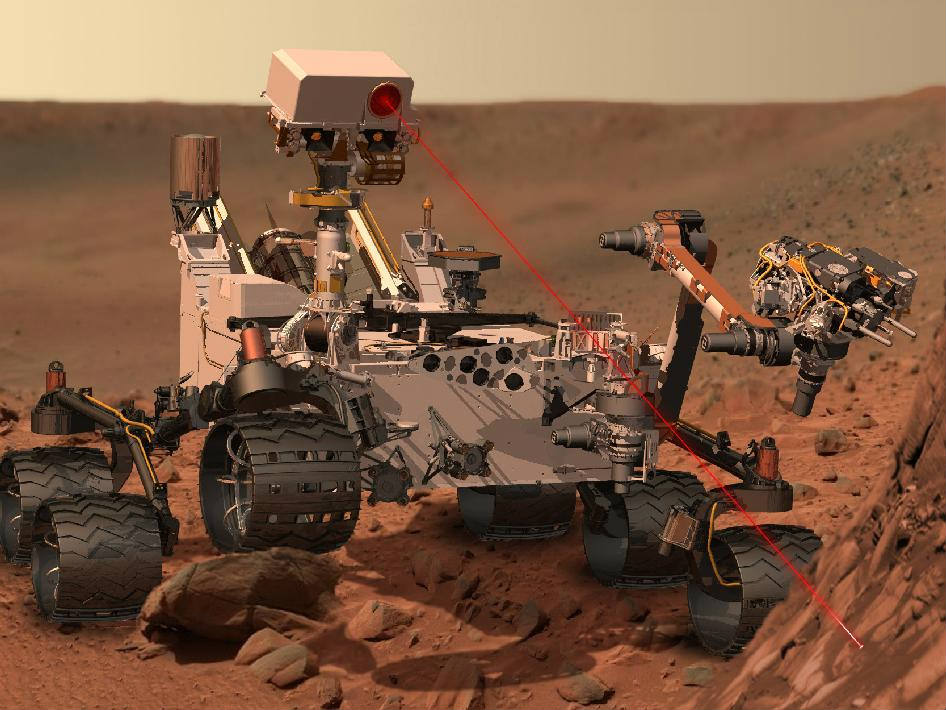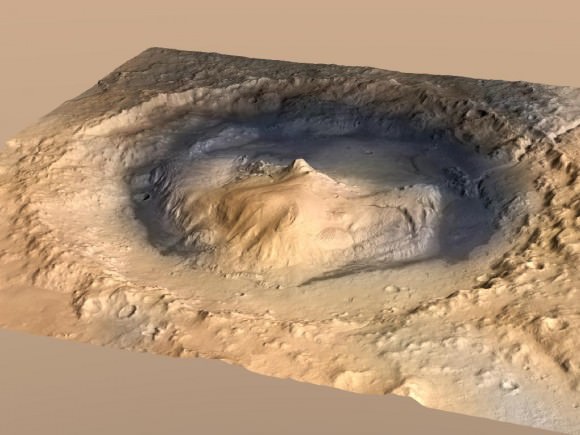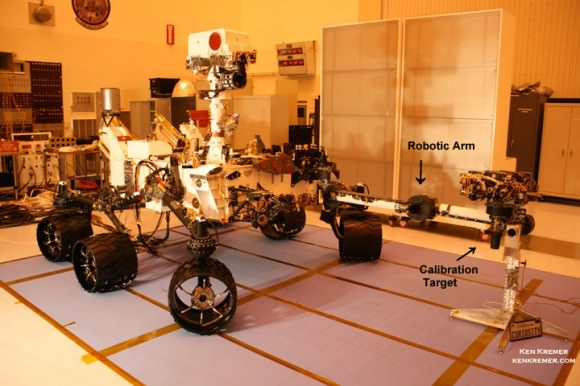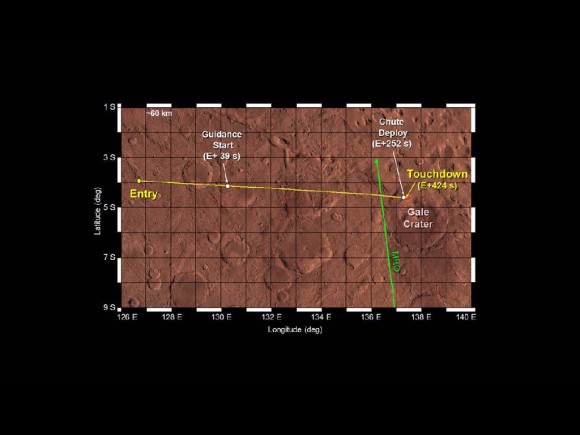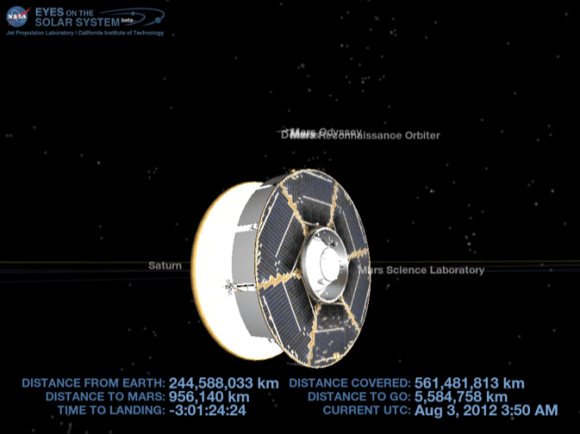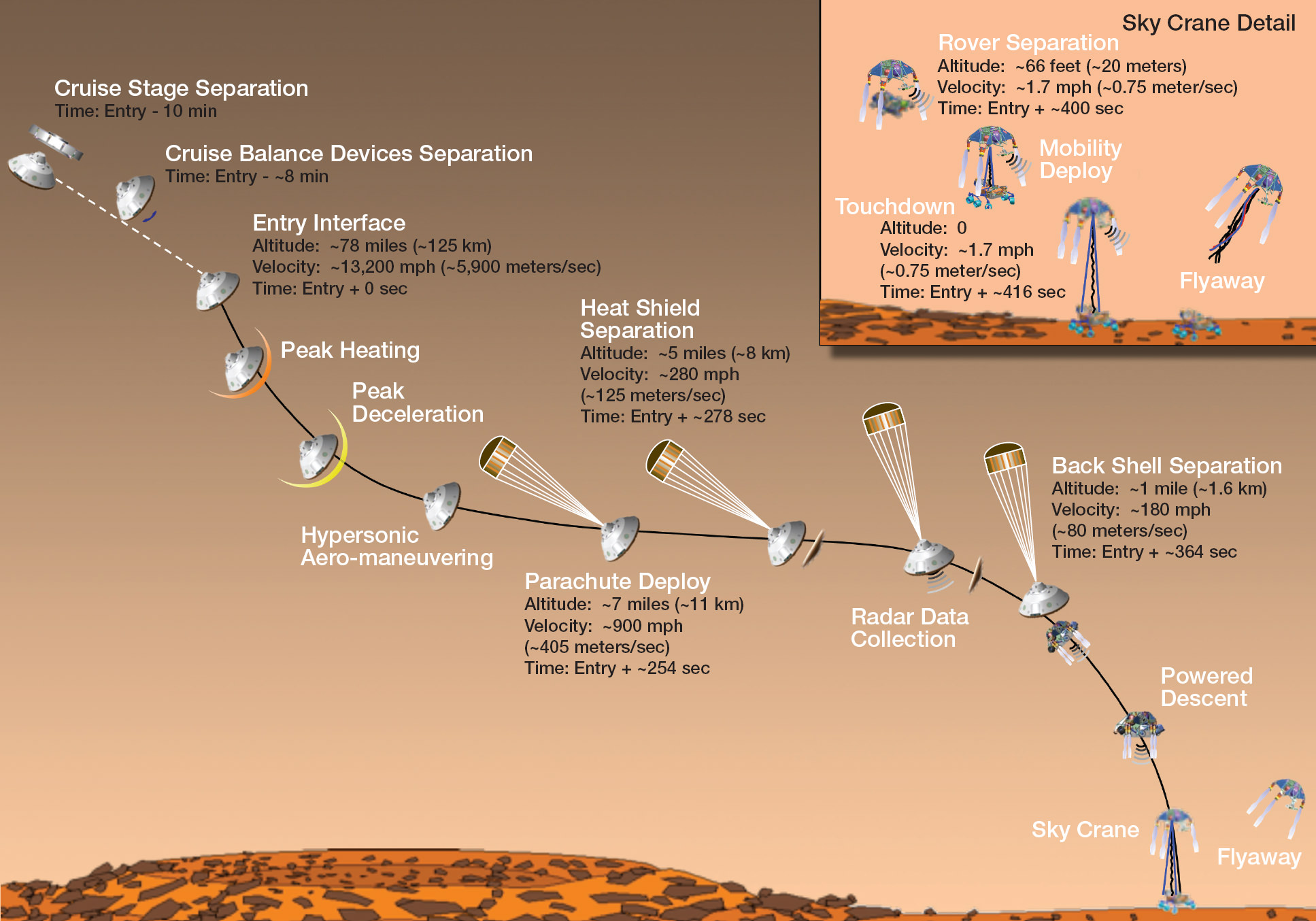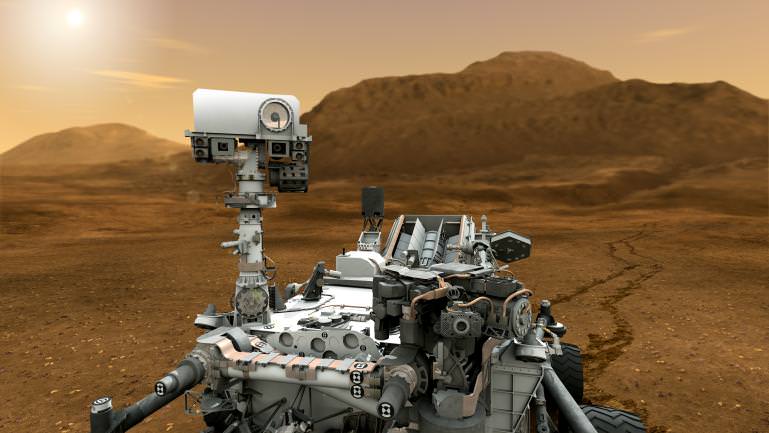Image Caption: This graphic shows the locations of the cameras on NASA’s Curiosity rover. The rover’s mast features seven cameras: the Remote Micro Imager, part of the Chemistry and Camera suite; four black-and-white Navigation Cameras (two on the left and two on the right) and two color Mast Cameras (Mastcams). Image credit: NASA/JPL-Caltech
If all goes well with the high stakes descent, the first images from the 1 ton Curiosity rover on the Martian surface could be received in the first few minutes after touchdown inside Gale Crater beside a huge mountain with layered sediments – now less than a day away.
It all depends on whether Curiosity successfully establishes a communications link with NASA’s Mars Odyssey signal relay spacecraft as the resilient orbiter simultaneously flies over the landing site and transmits the vital data indicating “Yes I’m Alive” to tracking stations back on Earth for analysis by anxiously waiting engineers at NASA’s Jet Propulsion Lab in Pasadena, Calif.
“We are expecting Odyssey to relay good news,” said Steve Sell of the JPL engineering team that developed and tested the mission’s complicated and never before used “sky crane” landing system. “That moment has been more than eight years in the making.”
The initial pictures would be reduced-resolution fisheye black-and-white images from the Hazard-Avoidance cameras (Hazcams), attached to the front and rear body of the rover.
“On the first night we expect the first low resolution black-and -white images from the rear hazcam, thumbnails about 50 x 50 pixels” said JPL’s Richard Cook, deputy project manager for Curiosity at today’s (Aug. 4) news briefing for reporters at JPL. “The Mars Odyssey relay will continue for 2 to 5 minutes after landing. Later that first night we hope to get a 512 x 512 pixel image looking out the rear of the rover.”
The hazcam cameras are covered with protective clear dust covers so the initial pictures might be taken through the covers if they haven’t popped off yet, Cook explained.
“The next chance to receive data and pictures comes 2 hours later post-landing during the second Odyssey over flight,” he added. “The next opportunity after that comes about 12 hours later.”
Initial thumbnail images from the rovers Mars Descent Imager (MARDI) camera,located on the belly of the rover, during the descent to the Red Planet’s surface are expected a day later on Aug. 7. These images will help pinpoint Curiosity’s exact location.
The team expects to deploy the rover’s mast with the higher resolution cameras on Aug. 7. Curiosity would then begin acquiring a 360 degree stereo panorama with the Navcam cameras the next day on Aug. 8.
The first color images are expected around Aug 8 from the Mars Hand Lens Imager, or MAHLI, one of five devices on the rover’s Inspector Gadget-like robotic arm. MAHLI will still be in the stowed position when it snaps the initial pictures.
But the whole plan depends on a successful landing and engineering checkout and instrument deployments along with no significant technical problems.
Navigators guiding NASA’s Curiosity Mars Science Lab (MSL) are threading the needle in these final 24 hours as she accelerates towards a miniscule target box barely 2 miles by 7 miles (2.8 by 11.5 kilometers) wide.
“We’re now right on target to fly through the eye of a needle, that is, our target at the top of the Mars atmosphere,” said MSL mission manager Arthur Amador, JPL, at the briefing. “The target is a box that’s 3 kilometers (1.9 miles) by 12 kilometers (7.5 miles) in dimension. And we’re flying right through it.”
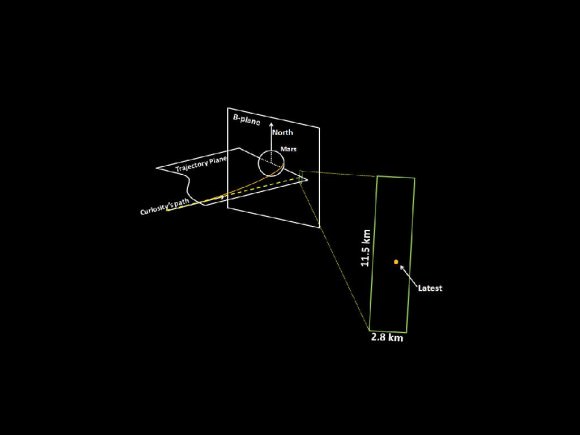
Image Caption: Eye of the Needle – This graphic shows how navigators steering NASA’s Mars Science Laboratory capsule — with the Curosity rover tucked inside — are aiming for a pinpoint location above Mars. They liken it to threading the eye of a needle. Navigators are aiming for a point inside of a target box that is 1.7 by 7.15 miles (2.8 by 11.5 kilometers) wide above the Red Planet. Mars’ gravity well, which has been precisely calculated, will pull the spacecraft into the Martian atmosphere. The plane in which MSL has been traveling toward Mars — labeled trajectory plane — hits what is known as the B-plane at a 90 degree angle. The B plane is the plane perpendicular to the velocity of the spacecraft when it is far away from Mars. It is used for maneuver targeting. The northward direction of Mars’ pole is also indicated. Credit: NASA/JPL-Caltech
As of Saturday evening, Aug 4, MSL has cut its distance from Mars in half in the past day. MSL is the same distance from Mars as the Earth is from the Moon, around 250,000 miles (400,000 km) and closing at more than 8000 MPH (about 3,600 meters per second).
“Right now, I’m closer to Mars than the moon is to Earth,” Curiosity just tweeted.
After the nail biting entry, descent and landing (EDL) , the 6 wheeled rover Curiosity is scheduled to touchdown inside Gale Crater at about 1:31 a.m. EDT (531 GMT) early on Aug. 6 (10:31 p.m. PDT on Aug. 5).
The 10 feet (3 meters) long mini Cooper sized Curiosity is loaded with 10 state-of-the-art science experiments that will search for organic molecules – the building blocks of life. She is the most sophisticated robot ever sent to the surface of another world. Curiosity will investigate the Red Planet like never before and look for signs of Martian microbial life and habitable zones by analyzing soil and rock samples with high powered analytical chemistry instruments.
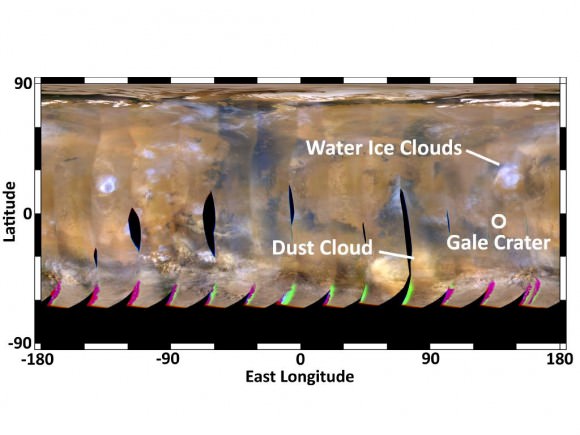
Image Caption: This global map of Mars was acquired on Aug. 2, 2012, by the Mars Color Imager instrument on NASA’s Mars Reconnaissance Orbiter. Image credit: NASA/JPL-Caltech/MSSS
And even the weather is cooperating.
“The active dust storm we saw south of Gale crater has now evolved into a harmless dust cloud. Basically, the poofed remnants of what was that dust storm. Mars is cooperating by providing good weather for landing,” said JPL’s Ashwin Vasavada, deputy project scientist for Curiosity.
“The team has done everything possible to make it a success. It is scary and risky. I am proud of the team,” said Doug McCuistion, director of the Mars Exploration Program at NASA Headquarters at the JPL briefing. “Risk exists.”
“The human spirit is driven by these kind of challenges. These challenges force us to explore our surroundings and understand what’s out there. And look at “Are we Alone?”
Watch NASA TV online for live coverage of the Curiosity landing on Aug. 5/6 starting at 11:30 pm EDT:
www.mars.jpl.nasa.gov or www.nasa.gov
Ken Kremer
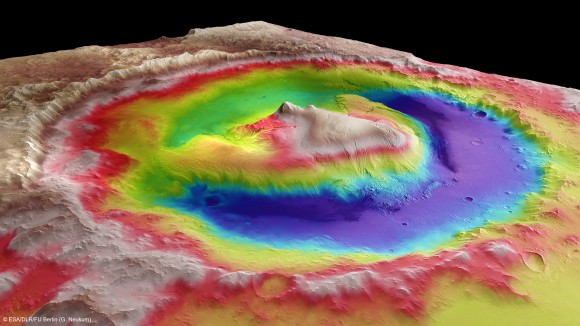
Image Caption: Curiosity Landing site at Gale Crater from ESA Mars Express Orbiter. Credits: ESA/DLR/FU Berlin (G. Neukum)
Read continuing features about Curiosity by Ken Kremer starting here:
Curiosity Precisely on Course at T Minus 48 Hours till a ‘Priceless Asset’ Lands on Mars
3 Days to Red Planet Touchdown – Watch the Harrowing Video of Car-Sized Curiosity Careening to Crater Floor
4 Days to Mars: Curiosity activates Entry, Descent and Landing Timeline – EDL Infographic
Curiosity’s Grand Entrance with Star Trek’s William Shatner and Wil Wheaton – Video Duet
Curiosity Completes Crucial Course Correction – 1 Week from Mars !
T Minus 9 Days – Mars Orbiters Now in Place to Relay Critical Curiosity Landing Signals
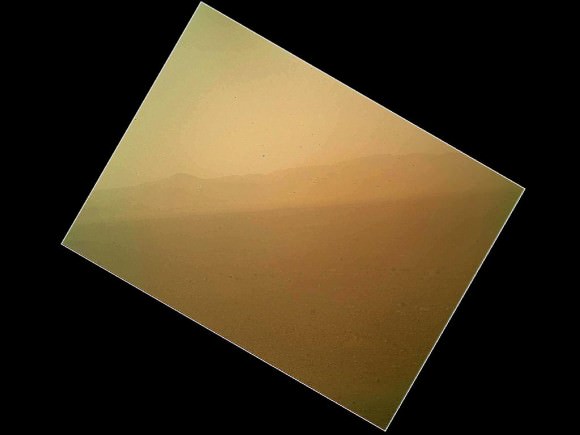

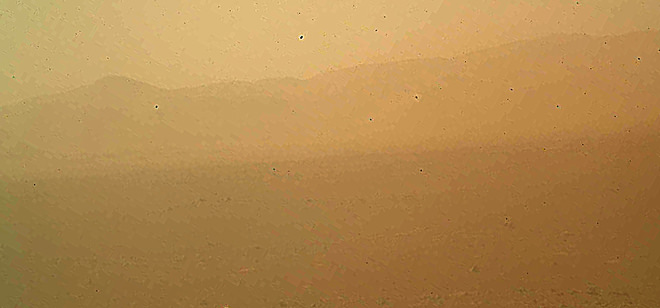
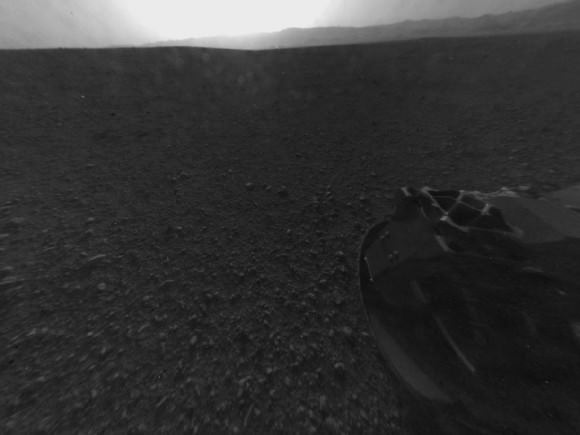
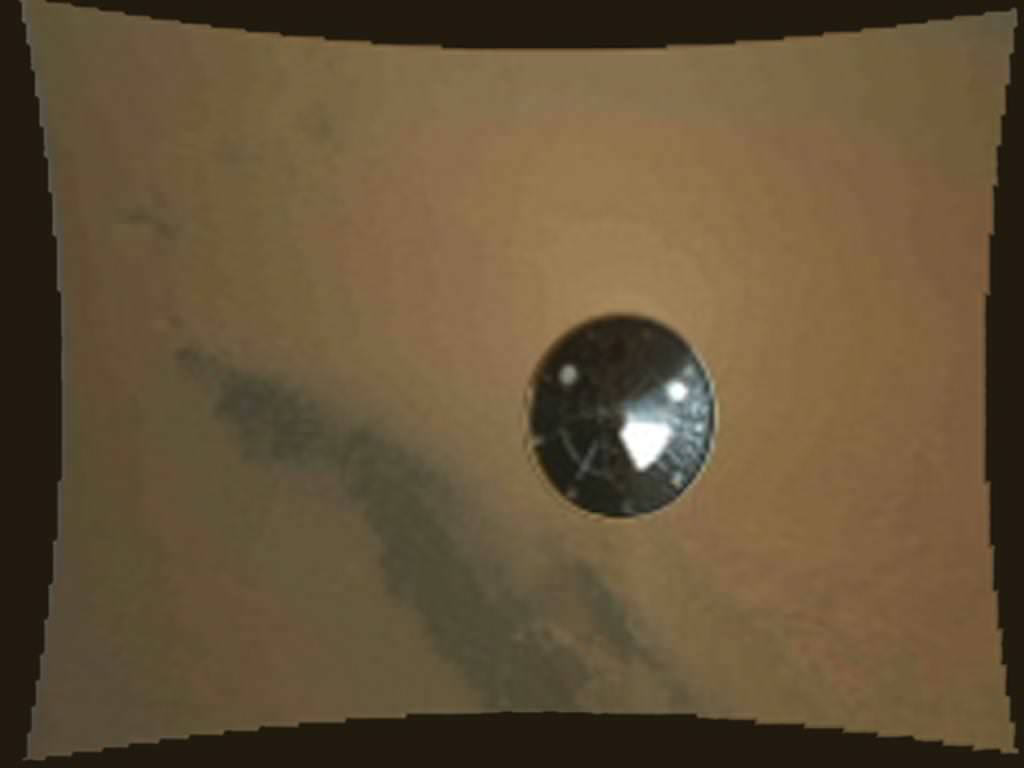
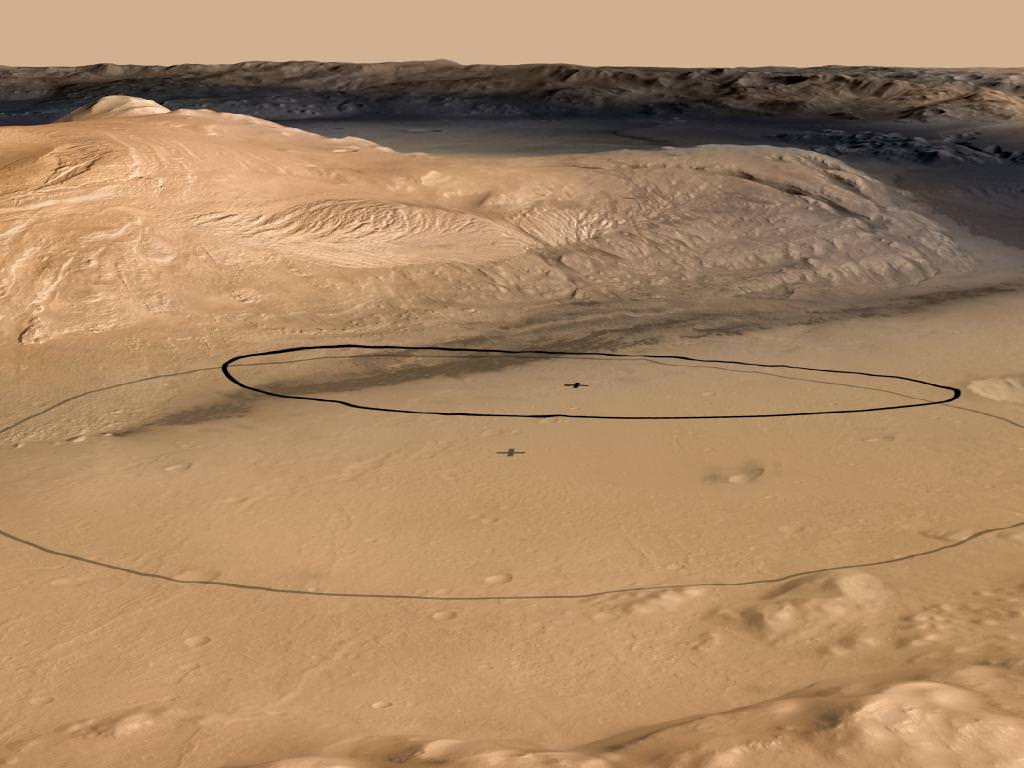
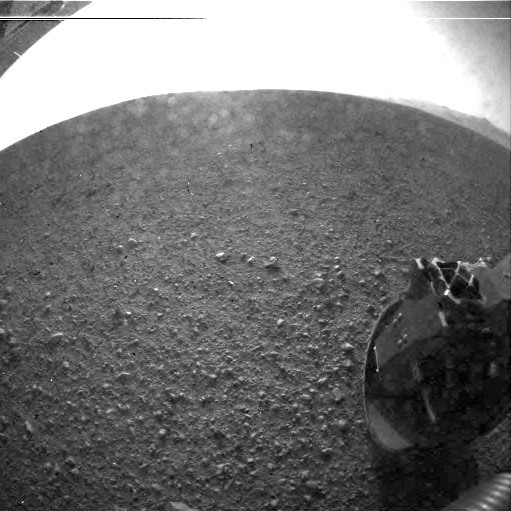
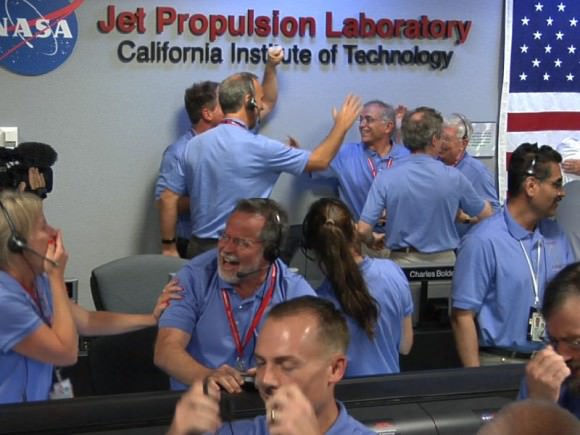
![PIA14294_Sumner1_curiosity_landing_site[1]](https://www.universetoday.com/wp-content/uploads/2012/08/PIA14294_Sumner1_curiosity_landing_site1-580x326.jpg)
